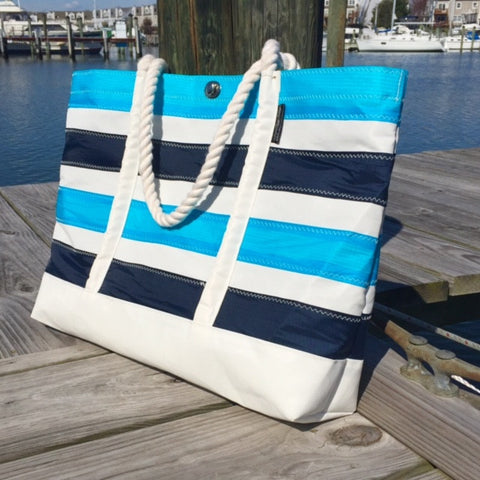Recycling your Used Sail March 7, 2015 10:07
The Life Of A Sail
Unfortunately nothing lasts forever. Sailors know this all too well as they will have to make many repairs and modifications to their vessels over the years to keep it afloat. The sailboat's engine, the sails themselves, sometimes get overlooked in this constant cycle of marine maintenance.
Your typical modern day sail is made from Dacron, which is a high density form of polyester. Some cruising sails remain hoisted on the boat for their entire lifespan, which becomes shorter if left unserviced. The exposed area of the leech and foot can become brittle and damaged by Ultraviolet Rays. You should have your local Sailmaker inspect your sails every two years to ensure their longevity. Even a properly serviced sail will someday reach a point where buying a new sail seems more attractive than repairing the old one.
On the other side of the spectrum, racing sailors will replace a sail every year or two just to ensure maximum performance. Many of these sails are made of Mylar plastic layers with either carbon fiber or Kevlar aramid bands laminated between them. Racing sails are also constructed from taffeta laminates, and lightweight nylon, depending on the type of sail.
A Sail's Afterlife
Considering that all of these sails are composed essentially of plastic fibers, it presents a significant problem to our every growing landfills. These forms of plastic are not commonly recyclable, though some companies, like Sunbrella, do recycle industrial canvas scraps back into new product. Your average sailor, however, cannot take his used sail to his sail-maker or community recycling center to get it converted into new fabrics. So, what happens to all these eco-unfriendly sails? I would bet most are being stored away in boat lockers and garages waiting to be deemed trash, or already at the county dump.
Damaged portions of a retired Dacron cruising sail can be cut away leaving the body of the sail behind. This is the majority of the sail, and in many cases remains in great shape structurally. Racing sails are also highly salvageable, often having much less wear and tear. Any sail fabric becomes softer over time, but still maintain its strength and water resistance.
While it no longer makes for a suitable sail, this material is perfect for outdoor pillows and cushion covers, that would look equally great inside. A used sail can be modified into an artsy backyard canopy, or a unique addition a child's tree house. Take it inside your home and use as window curtains, or even a stylish shower curtain. It could even make a great and portable projector screen.
Any amount of accessories can be made from sail cloth, and each type of fabric is suitable for differing applications. Here at Olde Dog, we focus on big Beach Bags, Travel Duffles, Crossbody bags, and Wallets. All products are handmade in small batches or are altogether unique. Most all recycled fabrics are washed prior to fabrication.

Used sails have also been used to create temporary structures for people in need, most noticeably in Haiti after the devastating hurricane of 2010. Not only did American sail making companies donate a great amount of used sails for individuals to make into shelters, some even personally fabricated the structures that housed stranded Haitian families. Sailsforsustenance.com is one charity that currently helps Haitian subsistence fisherman, who are in need of sails to reach better fish-able waters, helping to feed the community.
Help save the sails from the Landfill; if you have a used sail not in use, or know someone who does, contact a local handbag designer or canvas shop to have it made into your custom project. Or donate to a humanitarian effort. If you live in the Chesapeake Bay area, please contact me directly to donate your sail to a small artisan business.
Thanks,
Tomoldedogsewing@gmail.com

